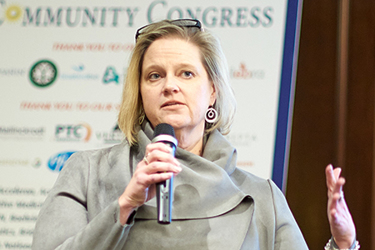Where Patients Meet Policy: The EveryLife Foundation For Rare Diseases

By Ben Comer, Chief Editor, Life Science Leader

Dr. Emil Kakkis, pictured on the cover of the April issue of Life Science Leader, founded Ultragenyx in 2010, a rare and ultra-rare disease medicines company. Kakkis has dedicated his professional career to the development of drugs to treat exceedingly small patient populations; as a result, he is keenly familiar with the ways in which regulatory and patient access systems can sometimes run counter to the best interests of rare disease patients and their families.
The year before he founded Ultragenyx, Kakkis created the EveryLife Foundation for Rare Diseases, a nonprofit patient advocacy organization focused on the “equitable development of and access to lifesaving diagnoses, treatments, and cures.” The foundation remains active. We caught up with Annie Kennedy, chief of policy and advocacy at the EveryLife Foundation, to learn more about the issues and policies the foundation is prioritizing this year. The following Q&A has been condensed and edited for clarity.
Subscribe to Life Science Leader to learn more about Kakkis and the business strategy behind Ultragenyx, a publicly traded company with three approved products and a pipeline that runs the gamut between gene therapies, a monoclonal antibody, an mRNA therapy and an antisense oligonucleotide. The company is also expanding its commercial reach in Europe and Asia through an ex-U.S. commercial deal with Regeneron Pharmaceuticals.
Q: What are your foundation’s top policy priorities this year?
Annie Kennedy: Our policy priorities are shaped by our commitment to the elimination of the diagnostic odyssey. That includes the development of expedited pathways for discovery and approval of safe and effective therapies for rare diseases. A broad issue that we've been working on is legislation called the Stat Act. The foundation of that legislation is based on the formation of a Center of Excellence at the FDA, focused on rare diseases. And we would really like for the FDA to consider the formation of a rare disease and condition advisory committee. We also want there to be additional focus on a rare disease therapy access program, because a lot of the access barriers we encounter are happening because payers aren't promptly receiving information and data to inform their decision making until the point when products are making it to the post-market setting.
Q: How would you rate the FDA’s patient-focused drug development program? Are there improvements you would like the agency to consider?
AK: In the last decade, we've come a long way. The engagement between the agency, patient organizations, social scientists, and the industry is vastly different today than it was, even when we were having these discussions five years ago around the PDUFA VI cycle. The engagement was meaningful, as was the patient experience data table. But we still don't know if it is really being considered in the review. What is new to us, but really important, is that payers now need to be a part of these conversations, too. We are now very focused on access as the end goal.
Q: You mentioned the diagnostic odyssey as a critical issue for rare disease patients. Several states have now passed so-called Recommended Uniform Screening Panel, or RUSP alignment bills. What impact might this have?
AK: Six states that have passed RUSP alignment legislation. And this year, we're working in Maryland, Mississippi, and Iowa. These laws are so critical because when something is added to the federal panel, it still needs an on-ramp for state implementation. RUSP alignment legislation needs three legs of the stool for it to work: There has to be a requirement that the conditions added in the state meet the evidentiary requirements of the Federal Advisory Committee; there have to be stated timelines, which are usually two to three years from the time it is listed on the federal panel to when it becomes listed at the state level; and there has to be funding and resources provided to the state in order to have the condition added. There are states that have passed bills with maybe one or two, but not all three aspects. One example was last year in North Carolina; they had two of the legs, but not the third. We worked with the state to have that third leg added. Now North Carolina is considered a RUSP alignment state.
Q: Are there any aspects of PDUFA VII, or Cures 2.0, that you would highlight as especially important for rare disease patients or drug developers?
AK: There is language around the Rare Disease Center of Excellence in the current draft of Cures 2.0. We are delighted that Rep. DeGette (D-CO) and Rep. Upton (R-MI) continue to prioritize that. We've been very engaged in PDUFA VII discussions, both with the FDA, as well as with BIO and PhRMA. One thing that could be improved is to further incentivize collaborations between sponsors, the FDA, and patient organizations within the precompetitive space. Rare disease communities often have to start all over when a product fails or a clinical trial ends, whether it is successful or not. There isn't consistency in those learnings and those discussions. Information gets lost when there’s a personnel change or a product is shifted over to a different review division. If there are more opportunities to look at these in a manner that is not connected to a specific IND, that would really optimize development. We’ve also been doing a lot of work in the Accelerated Approval space. We need to protect and strengthen the accelerated approval program for rare disease drugs. There are opportunities for earlier sponsor engagement and making determinations about post-market commitments, and the confirmatory trials that sponsors are required to conduct.
